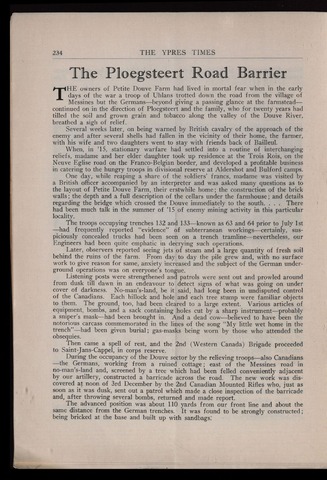The Ploegsteert Road Barrier
234
THE YPRES TIMES
THE owners of Petite Douve Farm had lived in mortal fear when in the early
days of the war a troop of Uhlans trotted down the road from the village of
Messines but the Germansbeyond giving a passing glance at the farmstead
continued on in the direction of Ploegsteert and the family, who for twenty years had
tilled the soil and grown grain and tobacco along the valley of the Douve River,
breathed a sigh of relief.
Several weeks later, on being warned by British cavalry of the approach of the
enemy and after several shells had fallen in the vicinity of their home, the farmer,
with his wife and two daughters went to stay with friends back of Bailleul.
When, in '15, stationary warfare had settled into a routine of interchanging
reliefs, madame and her elder daughter took up residence at the Trois Rois, on the
Neuve Eglise road on the Franco-Belgian border, and developed a profitable business
in catering to the hungry troops in divisional reserve at Aldershot and Bulford camps.
One day, while reaping a share of the soldiers' francs, madame was visited by
a British officer accompanied by an interpreter and was asked many questions as to
the layout of Petite Douve Farm, their erstwhile homethe construction of the brick
wallsthe depth and a full description of the cellars under the farmhouseand details
regarding the bridge which crossed the Douve immediately to the south. There
had been much talk in the summer of '15 of enemy mining activity in this particular
locality.
The troops occupying trenches 132 and 133known as 63 and 64 prior to July 1st
had frequently reported "evidence" of subterranean workingscertainly, sus
piciously concealed trucks had been seen on a trench tramlinenevertheless, our
Engineers had been quite emphatic in decrying such operations.
Later, observers reported seeing jets of steam and a large quantity of fresh soil
behind the ruins of the farm. From day to day the pile grew and, with no surface
work to give reason for same, anxiety increased and the subject of the German under
ground operations was on everyone's tongue.
Listening posts were strengthened and patrols were sent out and prowled around
from dusk till dawn in an endeavour to detect signs of what was going on under
cover of darkness. No-man's-land, be it said, had long been in undisputed control
of the Canadians. Each hillock and hole and each tree stump were familiar objects
to them. The ground, too, had been cleared to a large extent. Various articles of
equipment, bombs, and a sack containing holes cut by a sharp instrumentprobably
a sniper's maskhad been brought in. And a dead cowbelieved to have been the
notorious carcass commemorated in the lines of the song "My little wet home in the
trench"had been given burialgas-masks being worn by those who attended the
obsequies.
Then came a spell of rest, and the 2nd (Western Canada) Brigade proceeded
to Saint-Jans-Cappel, in corps reserve.
During the occupancy of the Douve sector by the relieving troopsalso Canadians
the Germans, working from a ruined cottage; east of the Messines road in
no-man's-land and, screened by a tree which had been felled conveniently adjacent
by our artillery, constructed a barricade across the road. The new work was dis
covered at noon of 3rd December by the 2nd Canadian Mounted Rifles who, just as
soon as it was dusk, sent out a patrol which made a close inspection of the barricade
and, after throwing several bombs, returned and made report.
The advanced position was about 110 yards from our front line and about the
same distance from the German trenches. It was found to be strongly constructed
being bricked at the base and built up with sandbags;

